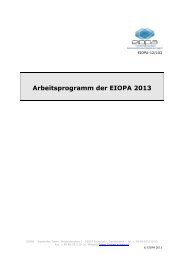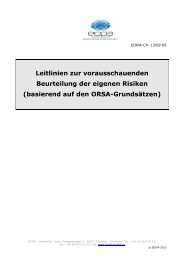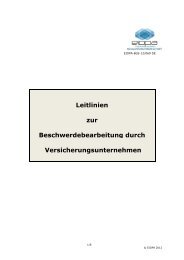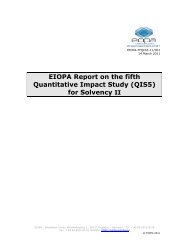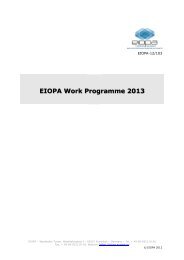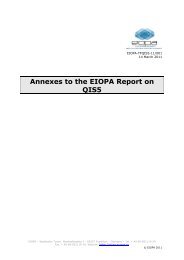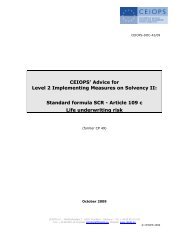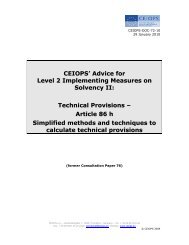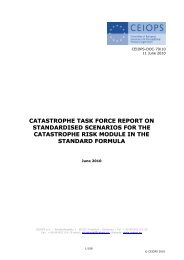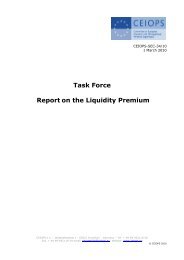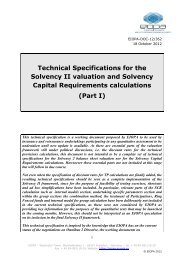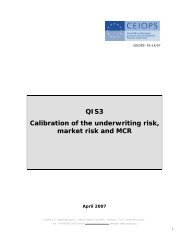Answers to the European Commission on the ... - Eiopa - Europa
Answers to the European Commission on the ... - Eiopa - Europa
Answers to the European Commission on the ... - Eiopa - Europa
Create successful ePaper yourself
Turn your PDF publications into a flip-book with our unique Google optimized e-Paper software.
Segmentati<strong>on</strong><br />
B.44 In general terms, an assessment of underwriting risk involves an<br />
identificati<strong>on</strong> of fac<str<strong>on</strong>g>to</str<strong>on</strong>g>rs that influence <str<strong>on</strong>g>the</str<strong>on</strong>g> variability of <str<strong>on</strong>g>the</str<strong>on</strong>g> underwriting<br />
result of <str<strong>on</strong>g>the</str<strong>on</strong>g> undertaking. This requires a classificati<strong>on</strong> of underwriting<br />
risks in<str<strong>on</strong>g>to</str<strong>on</strong>g> groups with similar characteristics, known as homogenous<br />
risk groups. This classificati<strong>on</strong> must be based in part <strong>on</strong> informati<strong>on</strong><br />
from his<str<strong>on</strong>g>to</str<strong>on</strong>g>rical data <strong>on</strong> <str<strong>on</strong>g>the</str<strong>on</strong>g> liabilities portfolio, <str<strong>on</strong>g>the</str<strong>on</strong>g> instituti<strong>on</strong>’s specific<br />
circumstances and relevant data from <str<strong>on</strong>g>the</str<strong>on</strong>g> insurance industry.<br />
B.45 The life underwriting risk groups <str<strong>on</strong>g>to</str<strong>on</strong>g> be used need fur<str<strong>on</strong>g>the</str<strong>on</strong>g>r examinati<strong>on</strong>.<br />
It is advisable <str<strong>on</strong>g>to</str<strong>on</strong>g> identify <str<strong>on</strong>g>the</str<strong>on</strong>g>se groups <strong>on</strong> an <str<strong>on</strong>g>European</str<strong>on</strong>g> level but<br />
nati<strong>on</strong>al specificities resulting in country-specific groups may be taken<br />
in<str<strong>on</strong>g>to</str<strong>on</strong>g> account. A suitable segmentati<strong>on</strong> of <str<strong>on</strong>g>the</str<strong>on</strong>g> book of business might be<br />
explicitly defined within <str<strong>on</strong>g>the</str<strong>on</strong>g> formula, or some flexibility could be<br />
allowed so that nati<strong>on</strong>al particularities can be taken in<str<strong>on</strong>g>to</str<strong>on</strong>g> account. A<br />
standard classificati<strong>on</strong> that is more closely aligned with actual<br />
undertakings behaviour should have positive c<strong>on</strong>sequences for risk<br />
management.<br />
O<str<strong>on</strong>g>the</str<strong>on</strong>g>r issues<br />
B.46 O<str<strong>on</strong>g>the</str<strong>on</strong>g>r issues that require fur<str<strong>on</strong>g>the</str<strong>on</strong>g>r analysis include:<br />
• ability <str<strong>on</strong>g>to</str<strong>on</strong>g> reflect an underlying TailVaR risk measure;<br />
• <str<strong>on</strong>g>the</str<strong>on</strong>g> treatment of guarantees and opti<strong>on</strong>s;<br />
• anti-selecti<strong>on</strong> (lapse rates, opti<strong>on</strong> take-up rates, etc.);<br />
• morbidity and disability risk;<br />
• interacti<strong>on</strong> effects (e.g. between lapse and mortality);<br />
• variati<strong>on</strong>s in sums assured; and<br />
• mortality improvement and trend risks.<br />
Underwriting risk in n<strong>on</strong>-life insurance<br />
Ma<str<strong>on</strong>g>the</str<strong>on</strong>g>matical framework for assessing underwriting risk<br />
B.47 In <str<strong>on</strong>g>the</str<strong>on</strong>g> following paragraphs, some basic notati<strong>on</strong> for <str<strong>on</strong>g>the</str<strong>on</strong>g> quantificati<strong>on</strong><br />
of underwriting risk under a fac<str<strong>on</strong>g>to</str<strong>on</strong>g>r-based approach is introduced. The<br />
aim here is <str<strong>on</strong>g>to</str<strong>on</strong>g> make both <str<strong>on</strong>g>the</str<strong>on</strong>g> discussi<strong>on</strong> of an underwriting risk<br />
treatment more transparent and also <str<strong>on</strong>g>to</str<strong>on</strong>g> provide a link with <str<strong>on</strong>g>the</str<strong>on</strong>g> general<br />
design of <str<strong>on</strong>g>the</str<strong>on</strong>g> SCR standard formula.<br />
B.48 To simplify, CEIOPS assumes that <str<strong>on</strong>g>the</str<strong>on</strong>g> time horiz<strong>on</strong> is <strong>on</strong>e business<br />
year. The forthcoming business year (at <str<strong>on</strong>g>the</str<strong>on</strong>g> point of time of <str<strong>on</strong>g>the</str<strong>on</strong>g><br />
solvency assessment) is referred <str<strong>on</strong>g>to</str<strong>on</strong>g> as <str<strong>on</strong>g>the</str<strong>on</strong>g> current year. The risk<br />
charge for underwriting risk is <str<strong>on</strong>g>the</str<strong>on</strong>g>refore derived from <str<strong>on</strong>g>the</str<strong>on</strong>g> properties of<br />
245



